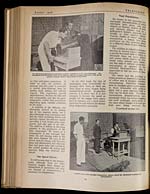John Logie Baird (1888-1946)
Recent advances in television : television by daylight and television in colours
AUGUST 1928
TELEVISION
[NLS note: a graphic appears here – see image of page]
Mr. Baird demonstrating his daylight television transmitter to Mr. Jack Buchanan. Mr.
Buchanan is an old school chum of Mr. Baird's, and, by a strange coincidence, they are at
present occupied within a stone's throw of each other.
no blue and green components. In
order to solve the problem, an
attempt was first made to construct
a special glow-discharge lamp by
mixing neon, helium, and mercury
vapour. This experiment proved
unsatisfactory, because the blue and
red components, and also the green
component, varied, their proportions
depending upon variable conditions
in the lamp.
A solution of the difficulty was
ultimately arrived at by making
use of two separate lamps, one a
glow-discharge lamp containing neon
and the other containing helium and
mercury vapour, the mercury vapour
providing a very intense green com-
ponent and also part of the blue.
The addition of helium in this lamp
assisted in the production of the
blue component. By means of a
commutator it was arranged that
while the red viewing holes in the
disc were between the eyes of the
viewer and the lamps, only the neon
lamp was illuminated, and when the
blue and green holes had rotated to
the correct position the helium and
mercury lamp was switched into
circuit.
The Speed Factor.
It will be seen that in this arrange-
ment, although there are three
separate images, these images are
transmitted in succession, and only
one channel of communication is
necessary for transmission.
On the other hand, the rate of
transmission must theoretically be
increased three times, as there are
three times as many images being
transmitted per second. In practice,
however, it is found that it is not
necessary to increase the speed so
greatly, for the images have many
parts in common, and a much lower
speed may be used without the flicker
being disagreeably noticeable.
[NLS note: a graphic appears here – see image of page]
Another view of the daylight transmitter, before which Mr. Buchanan is posing for
transmission.
Vast Possibilities.
By means of this apparatus very
successful demonstrations of colour
television were given, and such
objects as flowers, baskets of fruit,
and coloured objects, such as a
policeman’s helmet, appeared very
vividly in their natural colours,
Various shades of colour were also
transmitted, a human face being
portrayed on the receiving screen
in a different shade of pink from the
tongue.
The addition to television of repro-
duction in natural colours indicates
a greatly-increased field of utility, as
obviously there are many objects
and scenes which depend for their
visual value entirely upon colour;
one has only to witness colour cine-
matography as opposed to the
ordinary black-and-white film to
appreciate in full the force of these
remarks.
The writer had the privilege of
being present at demonstrations both
of colour and of daylight television
transmissions. Television transmis-
sion by daylight gives results similar
to those obtainable with artificial
light, but a more extended field of
view can be dealt with. The colour
transmission demonstrations were
amazingly vivid, the colours standing
out most strikingly, particularly in
the cases where images of flowers and
fruit were being received. The
(Continued on page 26.)
10


